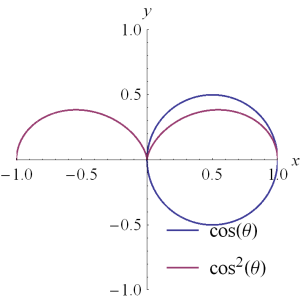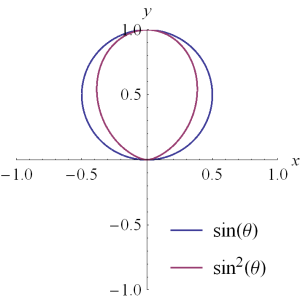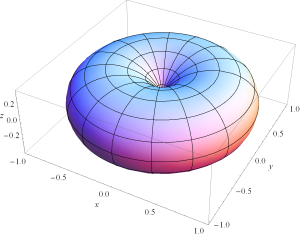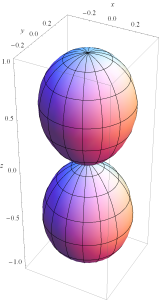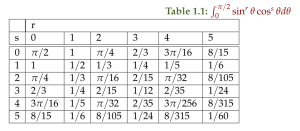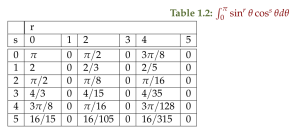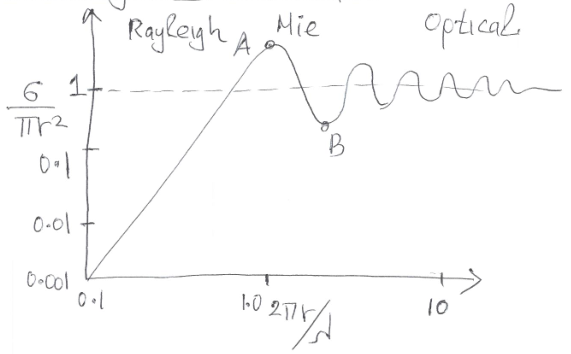[Click here for a PDF of this post with nicer formatting]
In [1] section 3.2 is a demonstration of the required (curl) form for the magnetic field, and potential form for the electric field.
I was wondering how this derivation would proceed using the Geometric Algebra (GA) formalism.
Maxwell’s equation in GA phasor form.
Maxwell’s equations, omitting magnetic charges and currents, are
\begin{equation}\label{eqn:phasorMaxwellsGA:20}
\spacegrad \cross \boldsymbol{\mathcal{E}} = -\PD{t}{\boldsymbol{\mathcal{B}}}
\end{equation}
\begin{equation}\label{eqn:phasorMaxwellsGA:40}
\spacegrad \cross \boldsymbol{\mathcal{H}} = \boldsymbol{\mathcal{J}} + \PD{t}{\boldsymbol{\mathcal{D}}}
\end{equation}
\begin{equation}\label{eqn:phasorMaxwellsGA:60}
\spacegrad \cdot \boldsymbol{\mathcal{D}} = \rho
\end{equation}
\begin{equation}\label{eqn:phasorMaxwellsGA:80}
\spacegrad \cdot \boldsymbol{\mathcal{B}} = 0.
\end{equation}
Assuming linear media \( \boldsymbol{\mathcal{B}} = \mu_0 \boldsymbol{\mathcal{H}} \), \( \boldsymbol{\mathcal{D}} = \epsilon_0 \boldsymbol{\mathcal{E}} \), and phasor relationships of the form \( \boldsymbol{\mathcal{E}} = \textrm{Re} \lr{ \BE(\Br) e^{j \omega t}} \) for the fields and the currents, these reduce to
\begin{equation}\label{eqn:phasorMaxwellsGA:100}
\spacegrad \cross \BE = – j \omega \BB
\end{equation}
\begin{equation}\label{eqn:phasorMaxwellsGA:120}
\spacegrad \cross \BB = \mu_0 \BJ + j \omega \epsilon_0 \mu_0 \BE
\end{equation}
\begin{equation}\label{eqn:phasorMaxwellsGA:140}
\spacegrad \cdot \BE = \rho/\epsilon_0
\end{equation}
\begin{equation}\label{eqn:phasorMaxwellsGA:160}
\spacegrad \cdot \BB = 0.
\end{equation}
These four equations can be assembled into a single equation form using the GA identities
\begin{equation}\label{eqn:phasorMaxwellsGA:200}
\Bf \Bg
= \Bf \cdot \Bg + \Bf \wedge \Bg
= \Bf \cdot \Bg + I \Bf \cross \Bg.
\end{equation}
\begin{equation}\label{eqn:phasorMaxwellsGA:220}
I = \xcap \ycap \zcap.
\end{equation}
The electric and magnetic field equations, respectively, are
\begin{equation}\label{eqn:phasorMaxwellsGA:260}
\spacegrad \BE = \rho/\epsilon_0 -j k c \BB I
\end{equation}
\begin{equation}\label{eqn:phasorMaxwellsGA:280}
\spacegrad c \BB = \frac{I}{\epsilon_0 c} \BJ + j k \BE I
\end{equation}
where \( \omega = k c \), and \( 1 = c^2 \epsilon_0 \mu_0 \) have also been used to eliminate some of the mess of constants.
Summing these (first scaling \ref{eqn:phasorMaxwellsGA:280} by \( I \)), gives Maxwell’s equation in its GA phasor form
\begin{equation}\label{eqn:phasorMaxwellsGA:300}
\boxed{
\lr{ \spacegrad + j k } \lr{ \BE + I c \BB } = \inv{\epsilon_0 c}\lr{c \rho – \BJ}.
}
\end{equation}
Preliminaries. Dual magnetic form of Maxwell’s equations.
The arguments of the text showing that a potential representation for the electric and magnetic fields is possible easily translates into GA. To perform this translation, some duality lemmas are required
First consider the cross product of two vectors \( \Bx, \By \) and the right handed dual \( -\By I \) of \( \By \), a bivector, of one of these vectors. Noting that the Euclidean pseudoscalar \( I \) commutes with all grade multivectors in a Euclidean geometric algebra space, the cross product can be written
\begin{equation}\label{eqn:phasorMaxwellsGA:320}
\begin{aligned}
\lr{ \Bx \cross \By }
&=
-I \lr{ \Bx \wedge \By } \\
&=
-I \inv{2} \lr{ \Bx \By – \By \Bx } \\
&=
\inv{2} \lr{ \Bx (-\By I) – (-\By I) \Bx } \\
&=
\Bx \cdot \lr{ -\By I }.
\end{aligned}
\end{equation}
The last step makes use of the fact that the wedge product of a vector and vector is antisymmetric, whereas the dot product (vector grade selection) of a vector and bivector is antisymmetric. Details on grade selection operators and how to characterize symmetric and antisymmetric products of vectors with blades as either dot or wedge products can be found in [3], [2].
Similarly, the dual of the dot product can be written as
\begin{equation}\label{eqn:phasorMaxwellsGA:440}
\begin{aligned}
-I \lr{ \Bx \cdot \By }
&=
-I \inv{2} \lr{ \Bx \By + \By \Bx } \\
&=
\inv{2} \lr{ \Bx (-\By I) + (-\By I) \Bx } \\
&=
\Bx \wedge \lr{ -\By I }.
\end{aligned}
\end{equation}
These duality transformations are motivated by the observation that in the GA form of Maxwell’s equation the magnetic field shows up in its dual form, a bivector. Spelled out in terms of the dual magnetic field, those equations are
\begin{equation}\label{eqn:phasorMaxwellsGA:360}
\spacegrad \wedge \BE = – j \omega \BB I
\end{equation}
\begin{equation}\label{eqn:phasorMaxwellsGA:380}
\spacegrad \cdot \lr{ -\BB I } = \mu_0 \BJ + j \omega \epsilon_0 \mu_0 \BE
\end{equation}
\begin{equation}\label{eqn:phasorMaxwellsGA:400}
\spacegrad \cdot \BE = \rho/\epsilon_0
\end{equation}
\begin{equation}\label{eqn:phasorMaxwellsGA:420}
\spacegrad \wedge (-\BB I) = 0.
\end{equation}
Constructing a potential representation.
The starting point of the argument in the text was the observation that the triple product \( \spacegrad \cdot \lr{ \spacegrad \cross \Bx } = 0 \) for any (sufficiently continuous) vector \( \Bx \). This triple product is a completely antisymmetric sum, and the equivalent statement in GA is \( \spacegrad \wedge \spacegrad \wedge \Bx = 0 \) for any vector \( \Bx \). This follows from \( \Ba \wedge \Ba = 0 \), true for any vector \( \Ba \), including the gradient operator \( \spacegrad \), provided those gradients are acting on a sufficiently continuous blade.
In the absence of magnetic charges, \ref{eqn:phasorMaxwellsGA:420} shows that the divergence of the dual magnetic field is zero. It it therefore possible to find a potential \( \BA \) such that
\begin{equation}\label{eqn:phasorMaxwellsGA:460}
\BB I = \spacegrad \wedge \BA.
\end{equation}
Substituting this into Maxwell-Faraday \ref{eqn:phasorMaxwellsGA:360} gives
\begin{equation}\label{eqn:phasorMaxwellsGA:480}
\spacegrad \wedge \lr{ \BE + j \omega \BA } = 0.
\end{equation}
This relation is a bivector identity with zero, so will be satisfied if
\begin{equation}\label{eqn:phasorMaxwellsGA:500}
\BE + j \omega \BA = -\spacegrad \phi,
\end{equation}
for some scalar \( \phi \). Unlike the \( \BB I = \spacegrad \wedge \BA \) solution to \ref{eqn:phasorMaxwellsGA:420}, the grade of \( \phi \) is fixed by the requirement that \( \BE + j \omega \BA \) is unity (a vector), so a \( \BE + j \omega \BA = \spacegrad \wedge \psi \), for a higher grade blade \( \psi \) would not work, despite satisifying the condition \( \spacegrad \wedge \spacegrad \wedge \psi = 0 \).
Substitution of \ref{eqn:phasorMaxwellsGA:500} and \ref{eqn:phasorMaxwellsGA:460} into Ampere’s law \ref{eqn:phasorMaxwellsGA:380} gives
\begin{equation}\label{eqn:phasorMaxwellsGA:520}
\begin{aligned}
-\spacegrad \cdot \lr{ \spacegrad \wedge \BA } &= \mu_0 \BJ + j \omega \epsilon_0 \mu_0 \lr{ -\spacegrad \phi -j \omega \BA } \\
-\spacegrad^2 \BA – \spacegrad \lr{\spacegrad \cdot \BA} &=
\end{aligned}
\end{equation}
Rearranging gives
\begin{equation}\label{eqn:phasorMaxwellsGA:540}
\spacegrad^2 \BA + k^2 \BA = -\mu_0 \BJ – \spacegrad \lr{ \spacegrad \cdot \BA + j \frac{k}{c} \phi }.
\end{equation}
The fields \( \BA \) and \( \phi \) are assumed to be phasors, say \( \boldsymbol{\mathcal{A}} = \textrm{Re} \BA e^{j k c t} \) and \( \varphi = \textrm{Re} \phi e^{j k c t} \). Grouping the scalar and vector potentials into the standard four vector form \( A^\mu = \lr{\phi/c, \BA} \), and expanding the Lorentz gauge condition
\begin{equation}\label{eqn:phasorMaxwellsGA:580}
\begin{aligned}
0
&= \partial_\mu \lr{ A^\mu e^{j k c t}} \\
&= \partial_a \lr{ A^a e^{j k c t}} + \inv{c}\PD{t}{} \lr{ \frac{\phi}{c} e^{j k c t}} \\
&= \spacegrad \cdot \BA e^{j k c t} + \inv{c} j k \phi e^{j k c t} \\
&= \lr{ \spacegrad \cdot \BA + j k \phi/c } e^{j k c t},
\end{aligned}
\end{equation}
shows that in \ref{eqn:phasorMaxwellsGA:540} the quantity in braces is in fact the Lorentz gauge condition, so in the Lorentz gauge, the vector potential satisfies a non-homogeneous Helmholtz equation.
\begin{equation}\label{eqn:phasorMaxwellsGA:550}
\boxed{
\spacegrad^2 \BA + k^2 \BA = -\mu_0 \BJ.
}
\end{equation}
Maxwell’s equation in Four vector form
The four vector form of Maxwell’s equation follows from \ref{eqn:phasorMaxwellsGA:300} after pre-multiplying by \( \gamma^0 \).
With
\begin{equation}\label{eqn:phasorMaxwellsGA:620}
A = A^\mu \gamma_\mu = \lr{ \phi/c, \BA }
\end{equation}
\begin{equation}\label{eqn:phasorMaxwellsGA:640}
F = \grad \wedge A = \inv{c} \lr{ \BE + c \BB I }
\end{equation}
\begin{equation}\label{eqn:phasorMaxwellsGA:660}
\grad = \gamma^\mu \partial_\mu = \gamma^0 \lr{ \spacegrad + j k }
\end{equation}
\begin{equation}\label{eqn:phasorMaxwellsGA:680}
J = J^\mu \gamma_\mu = \lr{ c \rho, \BJ },
\end{equation}
Maxwell’s equation is
\begin{equation}\label{eqn:phasorMaxwellsGA:700}
\boxed{
\grad F = \mu_0 J.
}
\end{equation}
Here \( \setlr{ \gamma_\mu } \) is used as the basis of the four vector Minkowski space, with \( \gamma_0^2 = -\gamma_k^2 = 1 \) (i.e. \(\gamma^\mu \cdot \gamma_\nu = {\delta^\mu}_\nu \)), and \( \gamma_a \gamma_0 = \sigma_a \) where \( \setlr{ \sigma_a} \) is the Pauli basic (i.e. standard basis vectors for \R{3}).
Let’s demonstrate this, one piece at a time. Observe that the action of the spacetime gradient on a phasor, assuming that all time dependence is in the exponential, is
\begin{equation}\label{eqn:phasorMaxwellsGA:740}
\begin{aligned}
\gamma^\mu \partial_\mu \lr{ \psi e^{j k c t} }
&=
\lr{ \gamma^a \partial_a + \gamma_0 \partial_{c t} } \lr{ \psi e^{j k c t} }
\\
&=
\gamma_0 \lr{ \gamma_0 \gamma^a \partial_a + j k } \lr{ \psi e^{j k c t} } \\
&=
\gamma_0 \lr{ \sigma_a \partial_a + j k } \psi e^{j k c t} \\
&=
\gamma_0 \lr{ \spacegrad + j k } \psi e^{j k c t}
\end{aligned}
\end{equation}
This allows the operator identification of \ref{eqn:phasorMaxwellsGA:660}. The four current portion of the equation comes from
\begin{equation}\label{eqn:phasorMaxwellsGA:760}
\begin{aligned}
c \rho – \BJ
&=
\gamma_0 \lr{ \gamma_0 c \rho – \gamma_0 \gamma_a \gamma_0 J^a } \\
&=
\gamma_0 \lr{ \gamma_0 c \rho + \gamma_a J^a } \\
&=
\gamma_0 \lr{ \gamma_\mu J^\mu } \\
&= \gamma_0 J.
\end{aligned}
\end{equation}
Taking the curl of the four potential gives
\begin{equation}\label{eqn:phasorMaxwellsGA:780}
\begin{aligned}
\grad \wedge A
&=
\lr{ \gamma^a \partial_a + \gamma_0 j k } \wedge \lr{ \gamma_0 \phi/c + \gamma_b A^b } \\
&=
– \sigma_a \partial_a \phi/c + \gamma^a \wedge \gamma_b \partial_a A^b – j k
\sigma_b A^b \\
&=
– \sigma_a \partial_a \phi/c + \sigma_a \wedge \sigma_b \partial_a A^b – j k
\sigma_b A^b \\
&= \inv{c} \lr{ – \spacegrad \phi – j \omega \BA + c \spacegrad \wedge \BA }
\\
&= \inv{c} \lr{ \BE + c \BB I }.
\end{aligned}
\end{equation}
Substituting all of these into Maxwell’s \ref{eqn:phasorMaxwellsGA:300} gives
\begin{equation}\label{eqn:phasorMaxwellsGA:800}
\gamma_0 \grad c F = \inv{ \epsilon_0 c } \gamma_0 J,
\end{equation}
which recovers \ref{eqn:phasorMaxwellsGA:700} as desired.
Helmholtz equation directly from the GA form.
It is easier to find \ref{eqn:phasorMaxwellsGA:550} from the GA form of Maxwell’s \ref{eqn:phasorMaxwellsGA:700} than the traditional curl and divergence equations. Note that
\begin{equation}\label{eqn:phasorMaxwellsGA:820}
\grad F
=
\grad \lr{ \grad \wedge A }
=
\grad \cdot \lr{ \grad \wedge A }
+
\grad \wedge \lr{ \grad \wedge A }
=
\grad^2 A – \grad \lr{ \grad \cdot A },
\end{equation}
however, the Lorentz gauge condition \( \partial_\mu A^\mu = \grad \cdot A = 0 \) kills the latter term above. This leaves
\begin{equation}\label{eqn:phasorMaxwellsGA:840}
\begin{aligned}
\grad F
&=
\grad^2 A \\
&=
\gamma_0 \lr{ \spacegrad + j k }
\gamma_0 \lr{ \spacegrad + j k } A \\
&=
\gamma_0^2 \lr{ -\spacegrad + j k }
\lr{ \spacegrad + j k } A \\
&=
-\lr{ \spacegrad^2 + k^2 } A = \mu_0 J.
\end{aligned}
\end{equation}
The timelike component of this gives
\begin{equation}\label{eqn:phasorMaxwellsGA:860}
\lr{ \spacegrad^2 + k^2 } \phi = -\rho/\epsilon_0,
\end{equation}
and the spacelike components give
\begin{equation}\label{eqn:phasorMaxwellsGA:880}
\lr{ \spacegrad^2 + k^2 } \BA = -\mu_0 \BJ,
\end{equation}
recovering \ref{eqn:phasorMaxwellsGA:550} as desired.
References
[1] Constantine A Balanis. Antenna theory: analysis and design. John Wiley & Sons, 3rd edition, 2005.
[2] C. Doran and A.N. Lasenby. Geometric algebra for physicists. Cambridge University Press New York, Cambridge, UK, 1st edition, 2003.
[3] D. Hestenes. New Foundations for Classical Mechanics. Kluwer Academic Publishers, 1999.

